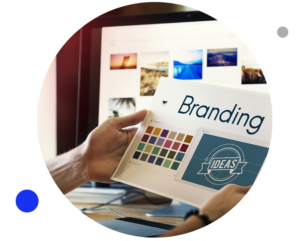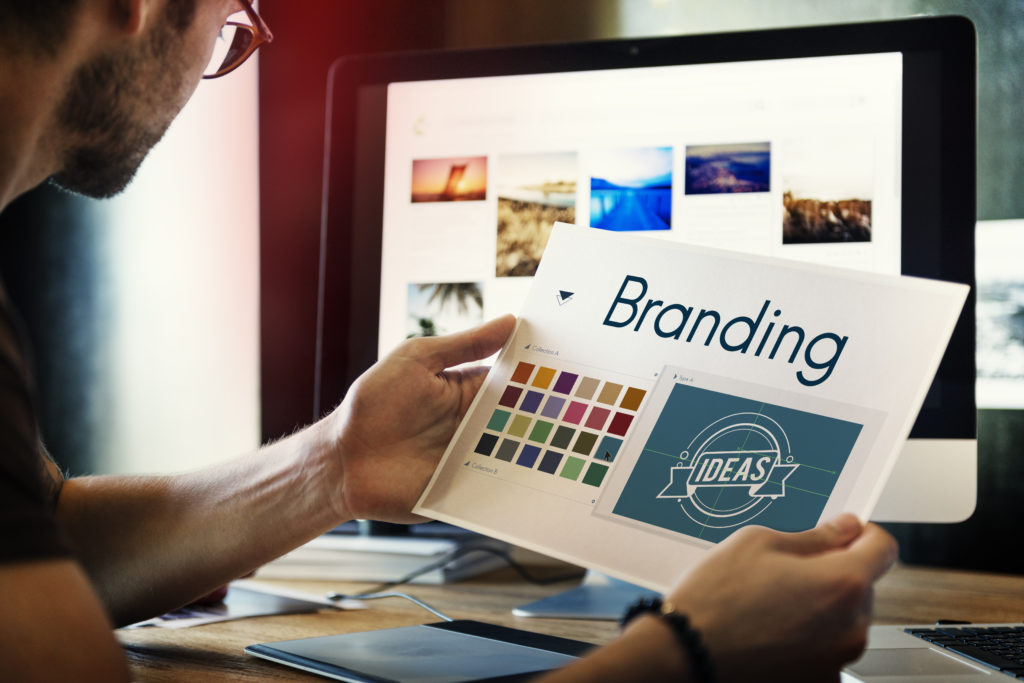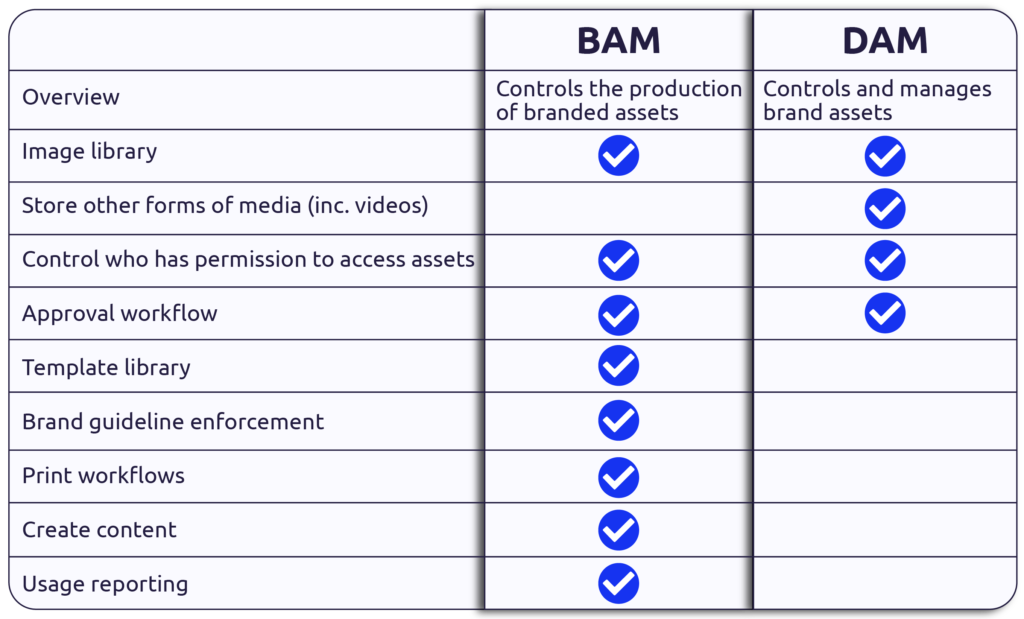
Brand asset management vs digital asset management
If you work in the areas of brand, marketing, communications, design and beyond, you might have heard of BAM and DAM. They aren’t just snazzy acronyms either; BAM stands for brand asset management while DAM stands for digital asset management.
Simply put, they’re both ways of managing assets across your organisation. They give you the capability to share specific files with anyone who needs them, removing the barriers to productivity.

It’s easy to think they’re just two terms for the same thing. However, there are key differences between BAM and DAM that will determine which you need.
If you’re asking whether you need BAM or DAM, our helpful guide is here to answer your questions.
What is digital asset management?
Digital asset management (DAM) focuses on managing your various digital assets, including logos, images and videos. It stores them in a central location so that anyone in your organisation has access when they need it.
Let’s say you have some fantastic product imagery that your marketing team want to add into an advert. Theoretically, they can pick it up from your DAM system without having to chase the files, making for a faster process.
Some DAM software also contains additional features, such as approval workflows, search, cataloguing and even usage rights. You may even store multiple versions of the same asset.
However, your DAM system won’t control how downloaded assets are used. It doesn’t give you the tools to create your desired outcomes. For example, if you’re making an advert, you’ll still need a designer to craft it from your assets. You’ll also need a robust approval process before it goes anywhere.
This is where brand asset management fills the gap.
What is brand asset management?
Brand asset management shares many similarities with DAM. Likewise, it will allow you to store digital assets and give the right people access.
Where it differs is what it allows people to do with those assets. A BAM system enforces your brand guidelines. Tailored templates ensure your assets are only used to create on-brand designs. It empowers anyone to craft well-designed brand content, even outside of your marketing or creative team.
Many will also offer approval workflows for added protection. The especially good ones (wink wink) might even extend beyond the visuals of your brand and incorporate elements like tone of voice. By including tone of voice in your brand management system, you’ll ensure your brand content speaks to customers in a suitable and consistent way, which leads to better experiences and increased trust.
By using a BAM, you can therefore maintain consistency and protect your brand in a way DAM can’t. With consistent brand presentation raising revenue by as much as 23%, a BAM system might deliver bigger rewards than you think.
Which one do I need?
Knowing what BAM and DAM are, the question is ‘which do I need for my organisation?’. It’s crucial to understand the difference between each. We’ve listed their respective features in our checklist below.
BAM vs DAM: a features checklist

Questions to ask
Another way to approach whether you need a BAM or DAM is understanding the goals of your organisation and the outcomes you want from the system. Fortunately, there are some simple questions you can ask to uncover your needs.
What are you trying to achieve?
The different features of BAM vs DAM mean they solve unique issues.
If the problem you face is sharing digital assets widely across your organisation, a DAM might be the right solution. It centralises your assets, including images, icons and videos, so people can access them when they need them. Many DAM systems also utilise version control for auditing purposes.
If your mission is to prevent the misuse of assets in off-brand content and alleviate the pressure on marketing, a BAM will answer your prayers. Branded templates ensure your images and logos are only used the correct way, making it easier to control. It also empowers your colleagues to create their own content rather than having to submit design requests to prevent production bottlenecks.
Who needs your assets and why?
You’d only consider a BAM or DAM if you had people you need to share assets with. Who you these are and what they might do with the assets is key to determining if a DAM or BAM works best.
DAM can be used by people across the company who need to utilise your assets in their jobs. Depending on how many users you are allowed, you may also appoint specific users who distribute the assets out more widely.
Examples might include developers who need to utilise images or files in a website or marketing teams to create marketing materials using product imagery. You must trust these users to use the assets correctly, so training may be required.
BAM is used by people who need to create assets on behalf of your company or charity. It’s especially useful if the people who need to produce them aren’t highly skilled in design or marketing. The BAM system will allow them to create content and comms that are on-brand regardless.
The templates offered in the BAM system ensure your brand guidelines are adhered to, always. Users will then be able to craft professional-looking assets to download and distribute, allowing for a faster process and consistent customer experiences.
Examples of people who might use a BAM system include:
- Fundraising teams who need to create materials to promote their cause
- Franchisees who want to promote their franchise while staying aligned to head offices’ marketing
- Distributors who need to promote and create content on behalf of a dealer
- Any non-marketing or design teams who need to provide brand content to customers, suppliers or other stakeholders
What do you need to share?
‘Digital assets’ and ‘brand assets’ mean different things.
Brand assets refer to collateral created for a brand and usually placed in front of a customer or other stakeholder. Examples include leaflets, flyers, posters, business cards, certificates, social media posts and so on.
Images will also be stored in the BAM, but only for the purpose of adding it into a template rather than downloading it directly.
Digital assets, on the other hand, could compromise a wide range of things. It includes images, icons, videos and other files. A DAM will allow a user to access and download these, but it won’t control how they go onto use them.
If you are sharing images and icons for the purpose of creating branded materials, a BAM needed. If you’re looking to share a wider range of files and aren’t governing how they’re used within the platform, a DAM should suffice.
Is your brand protected?
Many organisations believe DAM is all they need to facilitate productivity. However, all too often, they make the mistake of thinking their brand will take care of itself.
A DAM system is fine if you’re confident those who you’re sharing assets with know how to use them. If you’re giving access to people with the right skill and understanding of your brand guideline, such as marketing, design or comms teams, there’s less to worry about.
However, if there are people across the organisation creating content using your assets without the knowledge they need to stay on brand, you could be heading for disaster.
Giving people assets that don’t know how to use them properly leaves you exposed to inconsistent communications that lead to poor customer experience and declining trust. A BAM system will reduce the risk of this happening, allowing you to bring everyone on-brand and empower better content.
Can BAM and DAM work together?
Although we’ve talked about making the choice between brand asset management and digital asset management, it doesn’t necessarily mean you have to pick just one. DAM and BAM work in perfect unison, enabling you to grant access to your assets while protecting the brand.
Many BAM systems will integrate with your DAM software. This allows you to centralise the images, icons and other assets people may need to access, carrying through permissions, rights and updates.
Users can then take these assets and turn them into well-designed, on-brand content using the templates contained in your BAM. It’s the best of both worlds – plus you can sleep easy knowing your brand is protected!
What to look for in a BAM platform
If you’re seeking to protect your brand and give multiple users across your organisation the tools to create on-brand content, you need a BAM system.
There are a few things to consider when choosing a BAM system to make sure yours is right. We’ve listed the features to look out for below:
- Number of users – if you plan to have multiple people using your BAM, you need to have enough licences so that everyone has access. Check your system can meet your needs and at what cost.
- Range of templates – you need templates that fit your business needs, whether it’s social media posts or leaflet. Check that any BAM you consider offers all the templates you need, aligned to your brand guidelines.
- Ease of use – BAM should empower anyone to create on-brand content. The easier it is to use, the better. Training is an additional bonus to look out for.
- Approval workflows – although BAM should prevent brand mistakes, it’s always worth having a final check before it goes live. Many BAM systems will allow you to do this through approval workflows for extra peace of mind.
- Permissions – user permissions ensure people only have access to the templates and images they need to, so there’s no risk of things falling into the wrong hands.
- Reporting – most BAM systems will alert users when they’ve made an error, but some go a step further by analysing the common mistakes made. You can then focus on educating people for stronger brand governance.
- Additional extras – some BAM systems will offer helpful extras, such as tone of voice assistants, campaign kits and print services to give you even more value from your money.
- Post-sales support – adopting a BAM system into your organisation can be a challenge, so seek a provider who offers help to make the process easier while ironing out issues and setting it up correctly for your goals.
The brand asset management system you need
If you’ve decided a BAM system is right for you, RightMarket offers all the features you need to protect your brand and empower people to create great designs.
We’ll arrange a free Project Discovery session with you where we scope out your brand’s needs. During this, we also tell you how much you can expect to save (in both money and time) so you’ve already got some good news to share with your CEO.
From there, we build your own brand portal where users can create designs that meet your brand guidelines consistently. We’ll set up easy-to-use templates in line with the content people need to create, empowering anyone to design professional content regardless of skill or experience.
Our tone of voice assistant is also on hand to ensure everyone is speaking in the same customer-friendly language and avoids any mistakes. We’ll even provide reports on the common errors users make so you can educate them for the future.